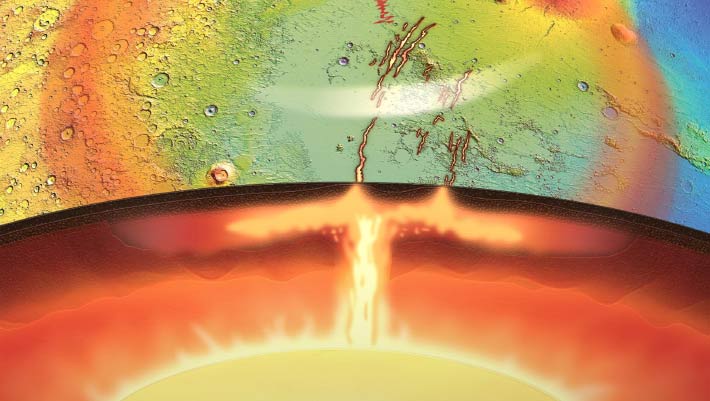Elysium Planitia, a flat-smooth plain just north of the Martian equator, is underlain by an 4,000-km-diameter active mantle plume, according to new research by scientists from the Lunar and Planetary Laboratory at the University of Arizona.
An artist’s impression of an active mantle plume — a large blob of warm and buoyant rock — rising from deep inside Mars and pushing up Elysium Planitia, a plain within the planet’s northern lowlands. Image credit: Adrien Broquet & Audrey Lasbordes.
Mars has typically been considered a geologically inactive world due to a lack of evidence of present-day tectonics and volcanic eruptions, especially compared to Earth.
However, NASA’s InSight lander recently detected low but constant seismic activity, which may originate from a nearby system of recently formed fissures called Cerberus Fossae.
Cerberus Fossae was also the location of Mars’ most recent volcanic event 53,000 years ago.
“Mars was most active 3 to 4 billion years ago, and the prevailing view is that the planet is essentially dead today,” said Dr. Jeffrey Andrews-Hanna, a researcher at the Lunar and Planetary Laboratory at the University of Arizona.
“A tremendous amount of volcanic activity early in the planet’s history built the tallest volcanoes in the Solar System and blanketed most of the northern hemisphere in volcanic deposits,” added Dr. Adrien Broquet, also from the Lunar and Planetary Laboratory at the University of Arizona.
“What little activity has occurred in recent history is typically attributed to passive processes on a cooling planet.”
In their study, Dr. Broquet and Dr. Andrews-Hanna analyzed the topography, gravity, and geology of Elysium Planitia, where both InSight and Cerberus Fossae are located.
Using geophysical models, the authors found evidence that the whole area sits over a mantle plume of hot material 95-285 K warmer than its surroundings. The center of the plume is located precisely at Cerberus Fossae.
Similarly to Earth, the presence of an active plume drives local sustained geological activity, including the marsquakes detected by InSight, and is the cause of the slow opening of the crust beneath the Cerberus Fossae.
These findings may indicate that Mars is only the third body in the inner Solar System, after the Earth and Venus, with currently active mantle plumes.
“Our study presents multiple lines of evidence that reveal the presence of a giant active mantle plume on present-day Mars,” Dr. Broquet said.
“We have strong evidence for mantle plumes being active on Earth and Venus, but this isn’t expected on a small and supposedly cold world like Mars,” Dr. Andrews-Hanna added.
The findings were published in the journal Nature Astronomy.
_____
A. Broquet & J.C. Andrews-Hanna. Geophysical evidence for an active mantle plume underneath Elysium Planitia on Mars. Nat Astron, published online December 5, 2022; doi: 10.1038/s41550-022-01836-3




